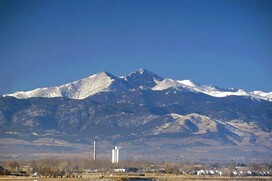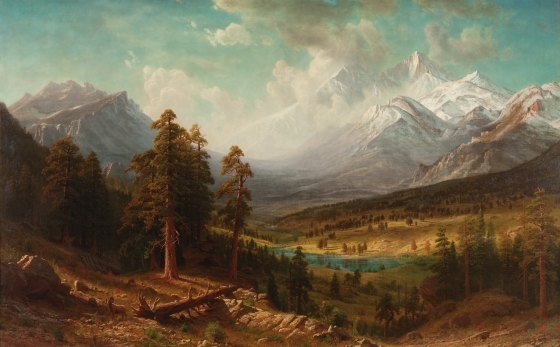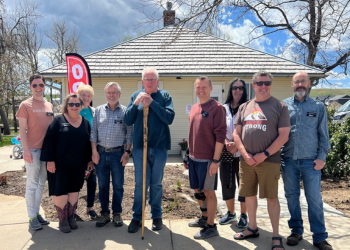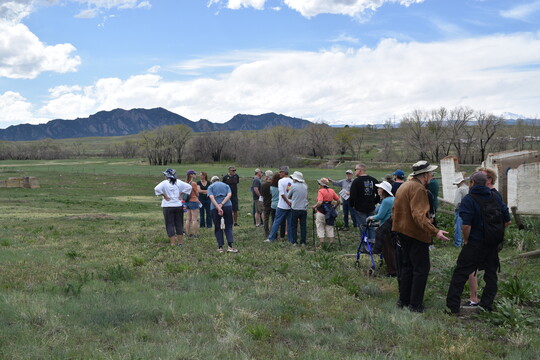Historical Commission Corner
Are you aware that you live in a desert? Well, according to Major Stephen H. Long, the first European to sight the massive peak that came to bear his name and tallest in the northern Colorado Rockies, the area around the 100th meridian appeared to be a desert. Long’s expedition of 1820 followed the Platte River upstream to the foothills of the Rocky Mountains and, upon observing the surroundings those many miles, declared the area west of the Missouri River as a “desert.”

Cartographers in subsequent years labeled their maps “The Great American Desert” based on Long’s conclusions; he added “unfit for cultivation” in his report, which impacted American History dramatically. The pioneer farmers plodding on trails west to California and Oregon skipped right over an area that was destined to become the “breadbasket of America.”
Major Long’s 14,259 foot namesake has a 13,911 foot twin: Mt. Meeker. Viewing Long’s Peak from the eponymous city of Longmont, the two peaks are quite obvious. There are many references to “Twin Peaks” in the Longmont area. The mount can be seen from Superior, but the viewer really is seeing Mt. Meeker, the southernmost twin.
|

This tallest denizen of Rocky Mountain National Park has many interesting facts; Here are a few samples. Native Americans followed trails from west of the continental divide through the area to hunt bison and collect eagle feathers.
In 1868 the first ascent of Long’s Peak was made by the noted explorer of the Grand Canyon, John Wesley Powell, and his survey party. Addie Alexander was the first female to reach the summit in 1871. English explorer and author Isabella Bird also climbed the mountain in 1873. The Prussian artist, Albert Bierstadt, painted many Colorado scenes in a style of romantic luminism, including Long’s Peak. Mt. Bierstadt is named for the late 19th Century painter.
|
Commission News

May 6 was an eventful day! The Historical Commission Open House at the Grasso Bungalow and the Historic Walk to the historic Industrial Mine were huge successes.
The Bungalow hummed with activity all day as visitors toured the temporary museum, took in displays and exhibits, patronized the taco truck, participated in a raffle for dramatic photos of Willie the horse fleeing the Marshall Fire, and caught up with friends and neighbors. Approximately forty walkers accompanied Commission guides to the Mine site to learn more about Superior’s mining past.
Among the winners of the raffle taking home a signed copy of Helen Richardson’s fantastic photo of Willie are Steve Bednar, Karen Brady, Jeanne Barrett and Mary Cartwright.
|
 Photo courtesy of Dalton Valette
The Historical Museum will open again on June 3 from 10:00 a.m. to 2:00 p.m.

We continue to receive more artifacts from our kind donors as we rebuild our collection. Thanks go out to recent donors:
-
Jennifer “JG” Garner - two wooden Dupont explosives powder boxes.
-
Charles Kranker - various tools, including a blow torch, used in the early 20th Century.
-
Lars Morales – child’s sled, scythe, and horse collar
-
Erroll Waligorski - Singer treadle sewing machine and antique washing machine.
|
Did You Know That:
-
The Spanish word for vein is veta? This explains the naming of the town of LaVeta and LaVeta Pass where the radiating veins of ore are obvious in the hard rock of West Spanish Peak.
-
Two hard rock miners claimed they found a wooden sailing ship in a crystal cave in the Eagle River Canyon near Red Cliff? The story serves as a reminder of how people hold on to legends regardless of fact.
-
The artist Christo engineered the hanging of a 200,000 square foot orange curtain across Rifle Gap near the town of Rifle in 1972? After a difficult unveiling, the nylon-polyamide curtain only lasted 27 hours as it was torn ragged by the winds blowing through the gap.
Written by Larry Dorsey, proofed by Dorothy Mahan.
For more information about the Historical Commission and its activities, contact Commission Liaison Jennifer Garner at 303-499-3675, Commission Chair Larry Dorsey at 303-499-1969, or just click on the “Historical Commission Info” button below.
|